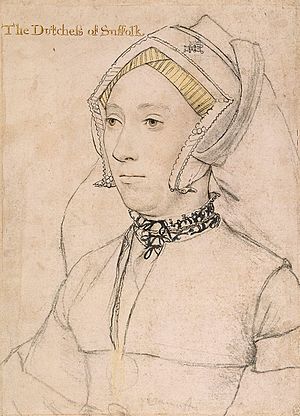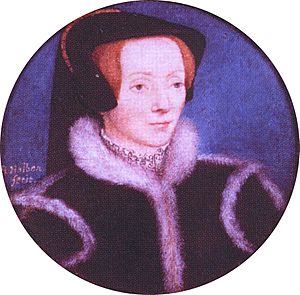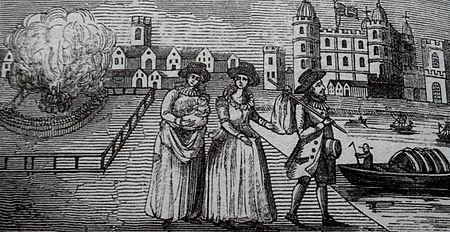Katherine Brandon, Duchess of Suffolk facts for kids
Quick facts for kids Katherine Willoughby |
|
|---|---|
| suo jure Baroness Willoughby de Eresby Duchess of Suffolk |
|
 |
|
| Katherine Willoughby, drawing by Hans Holbein the Younger | |
| Spouse(s) | Charles Brandon, 1st Duke of Suffolk Richard Bertie |
| Issue | |
| Henry Brandon, 2nd Duke of Suffolk Charles Brandon, 3rd Duke of Suffolk Susan Bertie, Countess of Kent Peregrine Bertie, 13th Baron Willoughby de Eresby |
|
| Noble family | Willoughby |
| Father | William Willoughby, 11th Baron Willoughby de Eresby |
| Mother | María de Salinas |
| Born | 22 March 1519 Parham Old Hall, Suffolk, England |
| Died | 19 September 1580 (aged 61) Grimsthorpe Castle, Lincolnshire, England |
Katherine Brandon, Duchess of Suffolk (born Katherine Willoughby; 22 March 1519 – 19 September 1580), was an important English noblewoman. She lived during the reigns of King Henry VIII, King Edward VI, and Queen Elizabeth I. She was the 12th Baroness Willoughby de Eresby in her own right, meaning she inherited the title herself.
Katherine was the fourth wife of Charles Brandon, 1st Duke of Suffolk. He was a close friend of King Henry VIII. Charles Brandon was also Katherine's legal guardian for a time. After Charles Brandon died in 1545, some people thought King Henry VIII might marry Katherine. This was even though he was still married to his sixth wife, Catherine Parr, who was Katherine's good friend.
Katherine strongly supported the English Reformation. This was a big change in England's religion. Because of her beliefs, she had to leave England when Queen Mary I became queen. Mary I was a Catholic and persecuted Protestants. Katherine fled to places like Wesel and the Grand Duchy of Lithuania to stay safe.
Contents
Her Family and Early Life
Katherine Willoughby was born on March 22, 1519, at Parham Old Hall in Suffolk, England. Her parents were William Willoughby, 11th Baron Willoughby de Eresby, and his second wife, María de Salinas. Katherine was christened in the church there a few days later.
Her mother, María de Salinas, came to England with King Henry VIII's first queen, Catherine of Aragon. María was one of the queen's closest friends and ladies-in-waiting. Katherine was likely named after Queen Catherine. Even though her mother was good friends with the Catholic Queen, Katherine later became a strong Protestant.
Katherine had two older brothers, Henry and Francis. Sadly, they both died when they were babies. This meant Katherine became her father's only surviving child.
Becoming an Heiress
Katherine probably spent her early childhood at Parham. Her mother was often with Queen Catherine of Aragon. When Katherine was seven years old, her father, Lord Willoughby, died on October 14, 1526. He had fallen ill during a visit to Suffolk.
As his only surviving child, Katherine inherited her father's title and lands. He owned many estates in Lincolnshire, Norfolk, and Suffolk. These lands were worth a lot of money. This made Katherine one of the wealthiest young women of her time.
However, inheriting these lands caused some problems. There were arguments about which lands belonged to her and which belonged to other family members. Her uncle, Sir Christopher Willoughby, even accused Katherine's mother of hiding important documents.
Becoming a Ward of the King
When Katherine's father died, she became a "ward" of the king. This meant the king was her legal guardian. On March 1, 1528, King Henry VIII sold Katherine's guardianship to his brother-in-law, Charles Brandon, 1st Duke of Suffolk.
The Duke of Suffolk quickly got involved in the family arguments over Katherine's inheritance. His involvement helped settle some of the disputes. Katherine was supposedly engaged to Henry Brandon, the Duke of Suffolk's son from his previous marriage. However, Henry Brandon died in 1534.
The Duke of Suffolk's third wife, Mary Tudor, Queen of France, died in 1533. Katherine, who was only fourteen, was one of the main mourners at her funeral.
Marriage to Charles Brandon
Even though Charles Brandon was forty-nine and Katherine was only fourteen, their marriage was successful. The Duke of Suffolk became a very powerful person in Lincolnshire. He helped stop a rebellion there in 1536. He also built a grand home called Grimsthorpe Castle, which Katherine later owned.
Katherine and the Duke had two sons:
- Henry Brandon, 2nd Duke of Suffolk, born in 1534.
- Charles Brandon, 3rd Duke of Suffolk, born in 1537.
Their marriage brought Katherine closer to the royal family. King Henry VIII's will said that the children of his younger sister, Mary Tudor (Charles Brandon's previous wife), would be next in line for the throne after his own children.
The Duke and Duchess of Suffolk officially welcomed Anne of Cleves when she came to England to marry the king in 1539. They also helped plan a royal visit for the king and his next wife, Catherine Howard, in 1541.
Her Strong Beliefs
Katherine was known for being clever, witty, and very interested in learning. By the end of King Henry VIII's reign, she was a strong supporter of the English Reformation. This was the movement that changed England from Catholicism to Protestantism.
She became a close friend of Henry VIII's last queen, Catherine Parr. Katherine greatly influenced Queen Catherine's religious views. In 1546, these views became controversial. The king even ordered Queen Catherine's arrest, but she managed to convince him to change his mind.
The Duchess of Suffolk once played a game at a party where she named Bishop Stephen Gardiner as the person she liked least. She even named her pet dog "Gardiner," which made everyone laugh when she called the dog to her. Years later, when Bishop Gardiner was in prison, she joked that "It was merry with the lambs when the wolf was shut up."
Duke Charles Brandon died in 1545. There were rumors that King Henry VIII was thinking about marrying Katherine as his seventh wife. She was still only in her mid-twenties. However, their friendship remained strong. After Henry VIII died in 1547, Katherine helped pay for the printing of one of Queen Catherine Parr's books.
Katherine also supported John Day, a leading publisher of religious books in England. She helped set up churches for foreign Protestants who were escaping religious persecution in other countries.
Life After Henry VIII's Death
After King Henry VIII died, Queen Catherine Parr married Thomas Seymour. In 1548, she had a daughter but sadly died a few days later. Her baby daughter, Mary Seymour, was left an orphan. The Duchess of Suffolk became Mary's guardian.
Katherine found it hard to support the baby and wrote to Sir William Cecil asking for money. It seems the baby Mary disappeared from history around this time. Some historians believe she died and was buried near Katherine's estate. Years later, Katherine also took care of one of her step-granddaughters, Lady Mary Grey. Mary was placed under house arrest for marrying without the queen's permission.
In 1551, both of Katherine's teenage sons, Henry Brandon, 2nd Duke of Suffolk and Charles Brandon, 3rd Duke of Suffolk, died on the same day from the sweating sickness. This was a terrible tragedy. Four months later, Katherine wrote that this sad event helped her understand God's power and love better. She built a new life after this loss. During this time, she hired Hugh Latimer as her chaplain.
Second Marriage and Exile
Katherine married her second husband, Richard Bertie, in 1553. He was a member of her household. They married for love and because they shared the same Protestant beliefs. Katherine continued to be known as the Duchess of Suffolk.
In 1555, during the reign of Queen Mary I, Katherine and Richard had to leave England. They were among the "Marian exiles" who fled to Europe to avoid being persecuted for their Protestant faith. Their difficult journey and persecution by Bishop Stephen Gardiner were written about in Foxe's Book of Martyrs. This famous book tells stories of Protestant martyrs.
During their exile, they lived in places like Wesel and the Grand Duchy of Lithuania. The King of Poland and Duke of Lithuania even appointed them to help manage Lithuania for a time.
After Queen Mary I died, Katherine and Richard returned to England. They lived at Katherine's estate, Grimsthorpe. With Richard Bertie, Katherine had two more children:
- Susan Bertie, Countess of Kent (born 1554).
- Peregrine Bertie, 13th Baron Willoughby de Eresby (born 1555). He was named "Peregrine" because it means "traveler" or "pilgrim," referring to their travels during exile.
Her Children
By her first marriage to Charles Brandon, Duke of Suffolk, Katherine had two sons:
- Henry Brandon, 2nd Duke of Suffolk (born 18 September 1535 – died 14 July 1551). He died from the sweating sickness.
- Charles Brandon, 3rd Duke of Suffolk (born 1537/38 – died 14 July 1551). He died from the sweating sickness about an hour after his older brother.
By her second marriage to Richard Bertie, Katherine had a daughter and a son:
- Susan Bertie, Countess of Kent (born 1554 – death date unknown). She married twice.
- Peregrine Bertie, 13th Baron Willoughby de Eresby (born 12 October 1555 – died 1601). He married Mary de Vere and they had seven children.
Katherine in Stories
Katherine and Richard Bertie's time in exile inspired some stories:
- A song called The most Rare and Excellent History, Of the Duchess of Suffolks Calamity by Thomas Deloney.
- A play called The Life of the Duchess of Suffolk by Thomas Drue, published in 1624.
- Her story may also have influenced the play The Duchess of Malfi by John Webster.
In modern fiction:
- Her story is told in a fictional way in The Sixth Wife: A Novel by Suzannah Dunn.
- She is played by Rebekah Wainwright in the TV series The Tudors, though her character's name and story are changed.
- She and Richard Bertie appear in Stanley Weyman's 1891 novel The Story of Francis Cludde. This book describes their escape from England during Queen Mary's reign.



